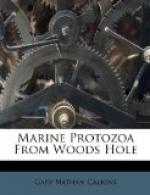Salt water.
Uronychia setigera, n. sp. Fig. 55.
This species is very common in the Woods Hole waters. It is small, colorless, and very active. The most characteristic feature is the posterior end with its relatively enormous cirri, which are apparently large enough for an animal four times its size. The form is ovoid, widened posteriorly.
The ventral surface is flat and has two excavations in the posterior end. The right hollow is larger and contains 5 great cirri of unequal size, the extreme right one being the largest. The left hollow contains 2 cirri, also of dissimilar size. Dorsal to the 5 right cirri are 3 sickle-formed cirri, which are usually fimbriated. These are pointed and curve regularly to the left. The peristome is wide and open, and a small pocket-like hollow on its left border indicates the region of the mouth. The adoral zone runs into this pocket and the mouth is located in its lower right-hand corner. In U. transfuga the right border is generally described as having a membrane of extreme delicacy. I was unable to see such a membrane in this form, but in its place there are 2 flagella-like cirri extending from the margin of the mouth-opening into the peristome, and these vibrate slowly. I do not believe these could be the moving edge of an undulating membrane, for they are quite distinct. The macronucleus is spherical instead of band-form, and a single micronucleus is closely attached. This is unlike the European species U. transfuga, in which the nucleus is elongate. The contractile vacuole lies between the two sets of posterior cirri. There are no marginal folds like those of the European species.
Length 40 mu; width 25 mu. Common.
[Illustration: Fig. 55.—Uronychia setigera.]
Genus ASPIDISCA Ehr. 1830.
(Perty ’52; Cl & Lach. ’58; Stein ’59;
Quennerstedt ’65, ’67, ’69;
Mereschowsky ’79; Kent ’81; Buetschli
’88.)
Small, colorless, and rigid forms, with nearly circular to oval contour. The left side is usually straight, or at least but slightly convex. The right side is much more convex, and the right margin is considerably thickened. The ventral side is flat, the dorsal surface convex, with from one to several longitudinal ridges which run more or less parallel with the right edge. The peristome is limited to the left edge, where it forms a small depression which may or may not reach the anterior border, but which in no case runs around the anterior margin. The left peristome margin in some cases grows over the peristome depression toward the right, thus making a sort of cover for the peristome. In the posterior region is a deep depression, from which 5 to 12 cirri take their origin. Seven or 8 cirri are placed in the anterior half of the ventral surface and are arranged more or less in rows. The anus is on the right side in the region of the anal cirri (Stein). The contractile vacuole is generally on the right side and similarly located. The macronucleus is a horseshoe-shaped body. Movement rapid, somewhat in circles, and rather uniform.




